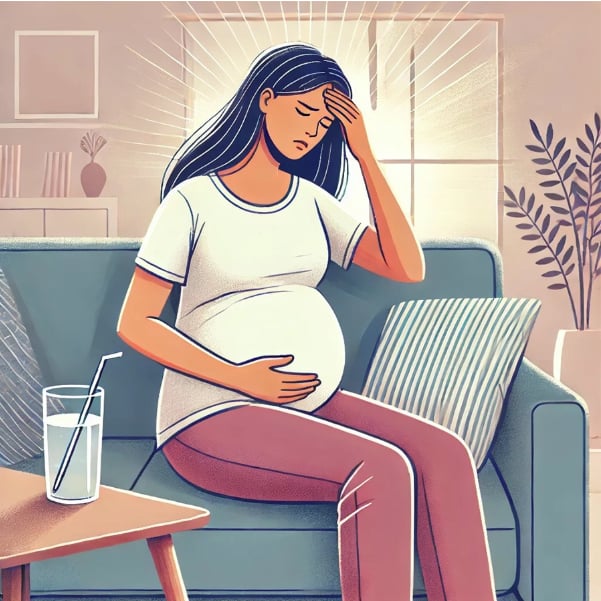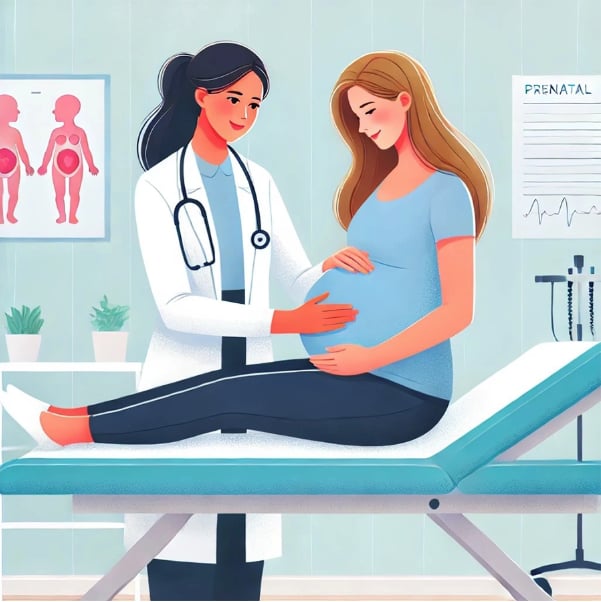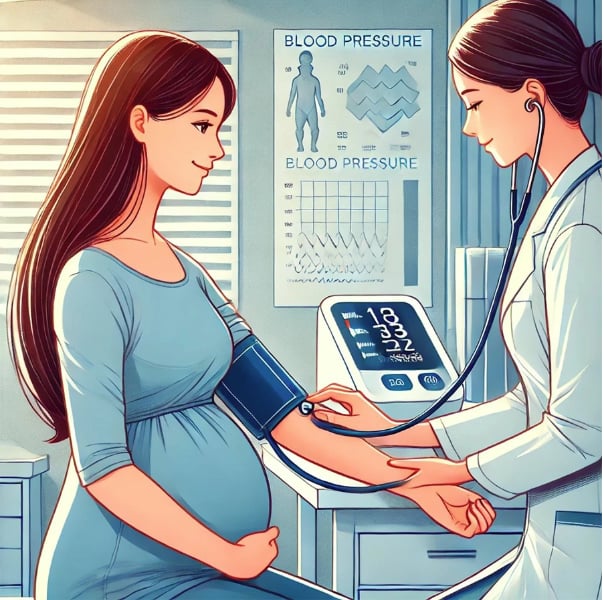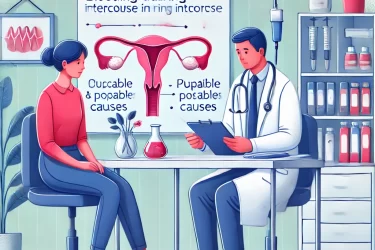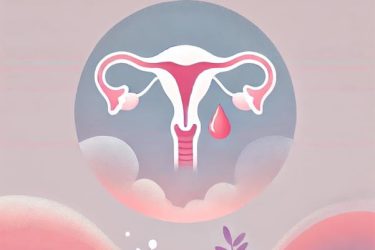Preeclampsia During Pregnancy: 6 Causes and Dangers
Preeclampsia During Pregnancy: 6 Causes and Dangers
Preeclampsia is one of the dangerous complications that can occur during pregnancy, threatening the health of both mother and baby. Understanding preeclampsia, its causes, signs and prevention is very important to ensure safety throughout the pregnancy. This article will provide a detailed look at preeclampsia, its causes and the potential dangers it brings.
1. What is preeclampsia?
1.1. Definition of preeclampsia
Preeclampsia is a pregnancy complication characterized by high blood pressure and signs of damage to other organs, usually the liver and kidneys. Preeclampsia usually occurs after the 20th week of pregnancy in women with previously normal blood pressure. If not treated promptly, preeclampsia can lead to serious complications, even endangering the lives of mother and fetus.
1.2. Classification of Preeclampsia
Preeclampsia is divided into two main types:
- Mild preeclampsia: Mild and controllable increase in blood pressure that does not cause serious symptoms.
- Severe preeclampsia: High blood pressure, accompanied by severe symptoms such as severe headache, visual disturbances, upper abdominal pain, and shortness of breath.
2. Causes of Preeclampsia
2.1. Genetic Factors
Genetics play an important role in the development of preeclampsia. If your mother or sister has had preeclampsia, you are at higher risk of developing the condition.
2.2. Medical History
Pre-existing medical conditions such as kidney disease, diabetes, high blood pressure before pregnancy, or autoimmune diseases such as lupus can all increase the risk of preeclampsia.
2.3. Special Pregnancy
Special pregnancies such as twins, triplets, or ectopic pregnancies can also increase the risk of preeclampsia.
2.4. Age Factors
Women who are over 35 or under 18 years old when they are pregnant for the first time are at higher risk of developing preeclampsia.
2.5. Lifestyle and Diet
Unhealthy lifestyles, lack of exercise, poor diet, obesity, and smoking can all increase the risk of preeclampsia.
2.6. Other Causes
Other factors such as inflammation, stress, and immune problems can also play a role in the development of preeclampsia.
3. Signs of Preeclampsia
3.1. High Blood Pressure
High blood pressure is the main sign of preeclampsia. If your blood pressure is 140/90 mmHg or higher, you should see your doctor for a check-up.
3.2. Swelling
Swelling, especially in the face and hands, can be a sign of pre-eclampsia. However, swelling can also be a normal phenomenon in pregnancy, so it should be combined with other symptoms to determine the exact cause.
3.3. Severe Headache
Severe headache, not relieved by using common painkillers, can be a sign of pre-eclampsia.
3.4. Visual Disturbances
Visual disturbances such as blurred vision, seeing spots or temporary loss of vision can also be signs of preeclampsia.
3.5. Upper Abdominal Pain
Pain in the upper abdomen, especially below the right rib cage, can be a sign of preeclampsia. This symptom is often caused by liver damage.
3.6. Nausea and Vomiting
Nausea and vomiting can be symptoms of many different problems, but when they occur along with other symptoms of preeclampsia, they need attention.
3.7. Decreased Urine Output
Reduced urine output or inability to urinate can also be a sign of preeclampsia, due to kidney damage.
4. Dangers of Preeclampsia
4.1. For the Mother
4.1.1. Organ Damage
Preeclampsia can cause damage to many internal organs such as the liver, kidneys and brain. If not treated promptly, it can lead to liver failure, kidney failure or cerebral hemorrhage.
4.1.2. Eclampsia
Eclampsia is the most dangerous complication of preeclampsia, characterized by uncontrolled seizures. Eclampsia can lead to coma, brain damage or even death if not treated promptly.
4.1.3. HELLP Syndrome
HELLP syndrome (Hemolysis, Elevated Liver enzymes, Low Platelet count) is a serious complication of preeclampsia, causing hemolysis, elevated liver enzymes and low platelet count. This syndrome can threaten the lives of both mother and fetus.
4.2. For the fetus
4.2.1. Fetal Malnutrition
Preeclampsia reduces blood flow to the placenta, leading to fetal malnutrition, growth retardation or premature birth.
4.2.2. Preterm Birth
Severe preeclampsia can lead to premature birth, with many health risks for the baby such as respiratory failure, infection and developmental problems.
4.2.3. Stillbirth
In severe cases, preeclampsia can lead to stillbirth.
5. How to Prevent and Treat Preeclampsia During Pregnancy
5.1. Prenatal Care
Regular prenatal care is the best way to prevent and detect preeclampsia early. Follow your doctor’s prenatal check-up schedule and monitor your health regularly.
5.2. Maintain a Healthy Lifestyle
Maintaining a healthy lifestyle, including a balanced diet, regular exercise, and avoiding stimulants such as tobacco and alcohol, can help reduce the risk of preeclampsia.
5.3. Control Blood Pressure
If you have a history of high blood pressure, control your blood pressure by following your doctor’s instructions, using blood pressure medication if necessary, and maintaining a low-salt diet.
5.4. Stress Reduction
Stress can increase the risk of preeclampsia. Try stress-reducing techniques such as yoga, meditation, and healthy recreational activities.
5.5. Medication Use as Prescribed
If you are at high risk of developing preeclampsia, your doctor may prescribe medication to reduce this risk. Follow your doctor’s instructions and dosage exactly.
5.6. Preeclampsia Treatment
If you are diagnosed with preeclampsia, your doctor will monitor you closely and may recommend treatments such as rest, blood pressure medications, and in severe cases, early delivery to protect the health of the mother and baby.
6. Frequently Asked Questions About Preeclampsia
6.1. Can Preeclampsia Be Completely Cured?
Preeclampsia cannot be completely cured, but it can be controlled with close health monitoring and timely treatment. After giving birth, the symptoms of preeclampsia usually subside and disappear.
6.2. Can You Get Pregnant Again After Preeclampsia?
Women who have had preeclampsia can still get pregnant again, but they need special monitoring and care to reduce the risk of recurrence. Talk to your doctor before deciding to get pregnant again.
6.3. Is Preeclampsia Hereditary?
Preeclampsia has a genetic component. If your mother or sister has had preeclampsia, you are at higher risk of developing the condition. Tell your doctor about your family history so that you can get appropriate advice and monitoring.
6.4. What Are the Signs That Preeclampsia Is Getting Serious?
Signs that preeclampsia is getting worse include very high blood pressure, severe headaches, visual disturbances, upper abdominal pain, decreased urine output, and difficulty breathing. If you experience any of these signs, go to the hospital immediately.
6.5. How to Reduce the Risk of Preeclampsia?
To reduce the risk of preeclampsia, you should maintain a healthy lifestyle, control your blood pressure, reduce stress, and follow a regular prenatal check-up schedule. Discuss with your doctor about preventive measures and regular health monitoring.
You may be interested in: Things pregnant women need to know in the first 6 weeks of pregnancy
Conclusion
Preeclampsia is a dangerous complication during pregnancy that can threaten the health and life of both mother and fetus. Understanding preeclampsia, its causes, signs, and prevention is very important to ensure safety throughout the pregnancy. Always pay attention to your health, follow a regular prenatal check-up schedule, and consult your doctor if there are any unusual signs.
Good health care during this period is a solid foundation for your baby’s healthy development throughout pregnancy and in the years to come.
Sito web: https://wiliit.com/
Pagina dei fan: https://www.facebook.com/wilimedia.en
Posta: Admin@wilimedia.com


